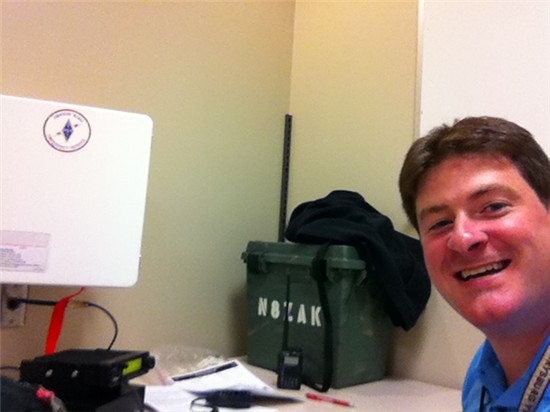
Monitoring 147.270/R and 145.670/S(FM/DV) and 442.750/DV in Toledo, Ohio
ARES
A lot of Amateur Radio operators are interested in more than communication and "hamming it up" on the radio. Some go a step farther and help their communities in a time of need. This is evident in situations such as severe weather, aircraft incidents, industrial accidents, acts of terror, etc. How do they help?
It's pretty simple really. Let's take an example...If you've ever seen a fire or even a major car accident, you'll see several firefighters and/or police cruisers and corresponding resources respond to that incident - sometimes clearing an entire firehouse and requiring more units to be called in on standby for the next emergency. Well imagine that a situation more intense calls for even more assets or a diagnosis of those incidents. That's where trained operators can help. Of course, this is just a simulated scenario, but ARES operators handle radio traffic in Hurricanes, Tornadoes, Power Outages, Cell and Phone Infrastructures outages, CERT functions, etc, etc, etc.
Trained radio operators can provide effective emergency communications at an instant's notice by originating, accepting, relaying and delivering tactical and formal message traffic timely and accurately on behalf of government, non-governmental agencies, and the general public.
This messaging is performed via fixed stations and field deployed personnel. These operators don't rely on any existing or commercial infrastructure or services. For example, trained ham radio operators accepted and passed thousands of emergency, health and welfare messages around the country and around the world during hurricane Katrina when all the cellular towers, phone lines, emergency backup generators, etc failed. Ham Radio and Emergency Communications worked - where ALL the other systems failed.
Here I am at a Lucas County ARES S.E.T. (Simulated Emergency Test) in September 2011.

As you can see, I've got a pretty big smile on my face, but I take these exercises pretty seriously. Basically, this exercise involved deploying to an area hospital to test the ARES radio equipment. The hospitals actually have a very nice setup. It consists of an ICOM IC-2100 radio. We performed Repeater and Simplex operational tests and inter-hospital communications. Some stations also took "Test" traffic over to the nightly ARES traffic net. As you can tell above, I also brought my ARES Go Kit to make sure I could interface with the existing hospital antenna if needed. In addition I brought my HT which was cross-banded to the truck parked on the parking structure of the hospital and that worked well also.
This event was nice from the standpoint that we were able to build relationships with the local hospitals and I was even able to talk with some of the people that had been walking by (nurses, technicians and EMS personnel). They seemed interested at what I was doing. My deployed counterpart K8RKS (Rick) went to the other radio room near the heli-pad, but an antenna issue prevented him from operating that backup station.
Want to be an even more effective and trained operator? Get trained by the Department of Homeland Security, FEMA, CERT, Red Cross. Your local ARRL district office or ARES members can help you get started.
Related resources
- Net Control How-To
- Zack's SKYWARN Page
- Lucas County ARES
- Wood County ARES
- Lucas County SKYWARN
- Wood County SKYWARN
